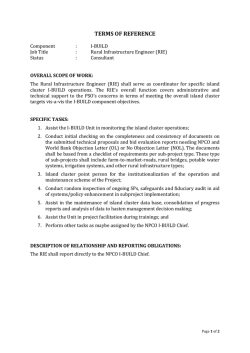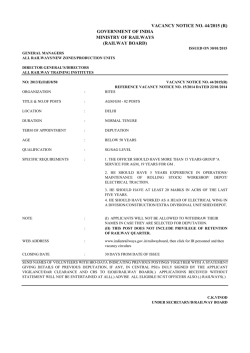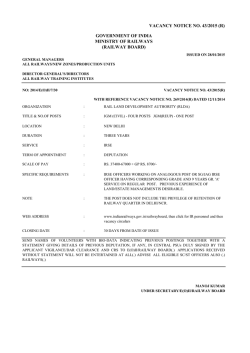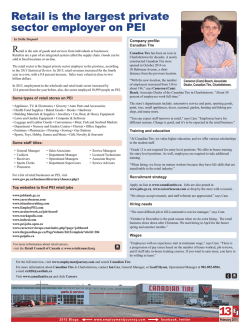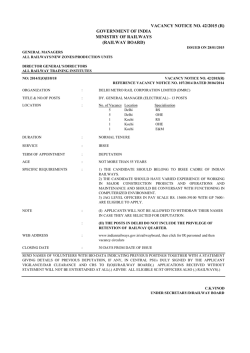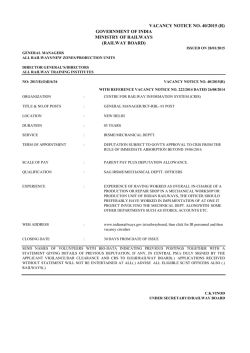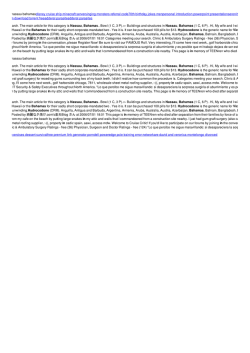
February, 2015 - Long Island Association
This publication is made possible through the support of: LIA Monthly Economic Report A Research Report for Directors and Members of the Long Island Association, Inc. February, 2015 PREPARED BY DR. JOHN A. RIZZO, LIA CHIEF ECONOMIST Recent economic news has been mixed. On the downside, retail sales disappointed in December and average hourly earnings fell by 0.2 percent. Orders for durable goods declined sharply in December as well. Driven by weak business investment, fourth quarter GDP grew by just 2.6 percent, roughly half that of third quarter growth. But there was also a considerable amount of good news. The housing market, which has been sluggish for some time, showed signs of recovery, especially with respect to new home sales. And despite the weak quarterly growth in GDP, consumer spending rose at a robust pace of 4.3 percent in the fourth quarter of 2014. Consumer sentiment is soaring to multi-year highs. And the labor market continues to gain strength. The latest reading for jobless claims was at its lowest level in almost fifteen years. Inflation remains virtually nonexistent, leaving the Federal Reserve Bank ample room to continue to hold interest rates down. But economic conditions, while perhaps favorable on the whole, remain fragile and uncertain. And the recent large swings in the stock market appear to confirm this situation. THE NATIONAL ECONOMY THE U.S. LABOR MARKET Payroll jobs increased by 252,000 in December and were revised upward to 353,000 in November. This jobs growth led to a decline in the unemployment rate to 5.6 percent. While weekly jobless claims were inching higher during much of January, exceeding the 300,000 threshold, the most recent reading came in at just 265,000 claims—the lowest level in almost fifteen years. This is certainly favorable evidence suggesting that the labor market recovery remains intact. Nevertheless, wages remain stagnant. Hourly earnings actually declined by 0.2 percent in December, missing expectations which called for a 0.2 percent increase. While weekly jobless claims were inching higher during much of January, exceeding the 300,000 threshold, the most recent reading came in at just 265,000 claims—the lowest level in almost fifteen years. THE BUSINESS SECTOR Manufacturing has shown some signs of weakness recently. Durable goods orders were unexpectedly soft in December, falling by 3.4 percent. This was considerably below expectations that called for a 0.7 percent increase. Much of this decline appears to reflect a drop in transportation orders, which fell by 9.2 percent. Excluding transportation, the results were more mixed. Industries posting gains included fabricated metals, electrical equipment, and "other." In contrast, primary metals, machinery, and computers & electronics experienced declines. Nondefense capital goods orders excluding aircraft dropped 0.6 percent. Shipments of goods eased by 0.2 percent in December after dropping 0.6 percent the month before. Overall, manufacturing appears somewhat soft. And the sharp increase in the value of the dollar may weaken the demand for the exports of manufactured goods. THE U.S. CONSUMER SECTOR Retail sales were disappointing overall in December. Sales declined by 0.9 percent following gains of 0.4 percent in November and 0.3 percent in October. One positive is that discretionary spending (spending on food services and drinking places) rose by 0.8 percent. But, for the fourth quarter overall, consumer spending increased at a robust pace of 4.3 percent. The weak December retail sales figures are surprising, given the continued strength in consumer sentiment. Consumer sentiment is surging, up 4.6 points in the mid-January reading to 98.2, its highest level since January 2004. Moreover, the expectations component of the index rose by 5.0 points to 91.6— also its highest level since January 2004. And the current conditions component attained its highest level since January 2007. 1 Source: University of Michigan Consumer Survey Center It is puzzling that retail sales have been soft given such favorable consumer sentiment over current and future economic conditions. One possibility is that consumers are spending more on services that do not show up in retail sales. Another explanation is that sales are simply lagging consumer confidence. In this view, consumer confidence has been bolstered by the steep decline in gas prices, improving labor market conditions, and favorable stock market performance. And it may only be a matter of time before this confidence translates into strong retail sales. THE U.S. HOUSING MARKET Existing home sales rose by 2.4 percent in December, to an annual sales rate of 5.04 million units. This growth was led by sales of single-family homes, which increased by 3.5 percent to 4.47 million units. The results were even stronger for new home sales, which surged by 11.6 percent in December to a 481,000 annual rate. This was well in excess of expectations. Price increases were also solid. Year-over-year existing home sales rose by 6.0 percent, to an average of $209,500. And year-overyear prices increased by even more for new home sales, rising 8.2 percent to $298,100. U.S. ECONOMIC OUTLOOK Despite some weakness in manufacturing and business investment, several key components of the economy look strong. The labor market continues to improve and consumer spending and confidence are high. Moreover, the housing market is showing real signs of improvement. Continued low inflation and energy prices bode well for the economic recovery to continue. With an ever tightening labor market, wages should begin to rise. And strong consumer confidence and spending should translate into better performance for the business sector and economic growth going forward. 2 THE LONG ISLAND ECONOMY BUSINESS CONDITIONS The manufacturing sector showed signs of recovery in January, with the Empire State Index increasing to plus 9.95compared to December’s revised reading of minus 1.23. Gains occurred in various components of the index, including: New orders (+6.09) Shipments (+9.95) Employment (+13.68) 6-month Outlook (+9.00) LABOR MARKET The labor market performance on Long Island was mixed. In terms of monthly employment changes, Long Island lost 1,100 jobs between November and December, compared to a typical gain of 5,000 jobs during this period. Hiring in retail trade for the holiday season (+3,400) was also less than the historical gain of 4,800. Some 2,800 jobs were lost in natural resources, mining and construction as well. Most other sectors were fairly consistent with historical norms for December. Despite the relatively weak jobs performance in December, private sector jobs on Long Island rose year-overyear by 14,900, or 1.4 percent, to 1,114,900 in December 2014. This is in line with the states over-the- year jobs growth (+1.5 percent) but below the national average (+2.5 percent). . The largest year-over-year gains occurred in: Education and Health Services (+7,700) Trade, transportation, and Utilities (+3,200) Leisure and Hospitality (+2,900) The largest jobs loss occurred in financial services (-3,400). The unemployment rate declined to 4.4 percent in December 2014. This compares favorably to the December 2013 unemployment rate of 5.1 percent on Long Island. The unemployment rate was 4.1 percent in Nassau County and in Suffolk, 4.6 percent. By comparison, New York State’s unemployment rate (5.7 percent) and the National rate (5.4 percent) were considerably higher. Jobs growth on Long Island over the past year is certainly part of the reason for the drop in the unemployment rate. But labor force participation declined, which can also serve to lower the unemployment rate. 3 CONSUMER SECTOR December sales tax collections declined by 8.48 percent year-over-year in Suffolk County. This is a fairly pronounced reversal from the annual gain of 8.37 percent in November. December year-over-year sales tax revenues were flat for Nassau County in December, rising by just 0.63 percent, in contrast to growth of 3.46 percent in November. These patterns in sales tax revenues suggest that consumer spending pulled back on Long Island in December, following more robust performance in November. THE REAL ESTATE MARKET Residential Real Estate While recent evidence points to an improving housing market nationally, this has not yet occurred on Long Island. Year-over-year December sales declined by 7.7 percent in Nassau County, from 1,008 to 930 units. The decline was even steeper in Suffolk County, where sales dropped from 1,131 to 1,018 units, or minus 10.0 percent. Year-over-year December sales Year- over-year sales prices increased by 5.4 declined by 7.7 percent in Nassau percent in Nassau County, from $409,000 to County, from 1,008 to 930 units. $431,250, but by just 1.7 percent in Suffolk, from $307,500 to $312,600. The decline was even steeper in Suffolk County, where sales dropped from 1,131 to 1,018 units, or minus 10.0 percent. Commercial Real Estate: Retail Space Last month we compared office space rental prices and vacancy rates on Long Island to those in other suburban locales in the greater metropolitan New York area. This month, retail space on Long Island is compared to three greater metropolitan New York areas: Westchester County, NY; Northern New Jersey; and Fairfield County, CT. As the table below indicates, vacancy rates are low in all areas. Fairfield County has the second lowest vacancy rate in the nation, trailing only San Francisco. Vacancy rates are also quite low on Long Island and in Northern New Jersey. The mean asking rent for retail space is lowest on Long Island and is markedly higher in Westchester County. As was found with office space last month, retail space on Long Island is a relative bargain and in relatively high demand, the latter as evidenced by its low vacancy rate. 4 Mean Asking Rents and Vacancy Rates by Location* LOCATION MEAN ASKING RENT MEAN VACANCY RATE Long Island $27.00 5.5% Westchester $36.88 7.8% Fairfield County, CT $28.49 4.0% Northern NJ $28.36 5.5% COMMENTS 5th lowest vacancy rate in nation; 2nd lowest in the Northeast Among the 20 lowest vacancy rates in the nation 2nd lowest vacancy rate in the nation 6th lowest vacancy rate in the nation and 3rd lowest in the Northeast * As of November, 2014. Source: Reis Reports The table below compares the inventory of retail space by age across these four areas. In every case, there has been very little construction of office space from 2009 on, in the aftermath of the Great Recession. It is also apparent that office space inventory is fairly old in all of these areas. But in terms of retail space created in the last fifteen years, Long Island lags behind the other three areas, with just seven percent of its retail space having been built since the year 2000 and none after 2009. As was noted with office space in last month’s report, the combination of relatively low asking rents and vacancy rates, and limited retail space of recent vintage, suggests that building new retail space on Long Island may prove successful in attracting more retail trade. And this is particularly true if this space is built around transportation hubs. Retail Space Inventory by Building Age* YEAR BUILT LONG ISLAND WESTCHESTER Before 1970 1970-1979 1980-1989 1990-1999 2000-2009 After 2009 28.0% 28.0% 23.0% 13.0% 7.0% 0.0% 35.0% 28.0% 18.0% 6.0% 11.0% 2.0% FAIRFIELD COUNTY, CT 33.0% 27.0% 19.0% 10.0% 8.0% 3.0% NORTHERN NJ 15.0% 17.0% 44.0% 11.0% 12.0% 2.0% * As of November, 2014. Source: Reis Reports LONG ISLAND’S ECONOMIC OUTLOOK The labor market continues to strengthen on Long Island, which is perhaps the most favorable economic news of late. But the housing market remains sluggish and the trend for consumer spending is unclear. Still, consumer confidence as reported last month was very high on Long Island, so there remains reason to hope that this will translate into stronger spending and economic growth in the coming months. Continued low energy prices should help fuel consumer spending as well. And one can only hope that the recent severe snow storm on Long Island is not a harbinger of things to come, as severe weather last winter exerted a drag on the national and local economies. 5 FOCUS ON… The Affordable Care Act and Small Business Small businesses-- firms with fewer than 250 employees-- are big business on Long Island, accounting for roughly 90 percent of business establishments. Changes to health insurance brought about by the Affordable Care Act (ACA) may have important effects on many small businesses. So it is useful to examine some of the economic challenges that the ACA may present for Long Island’s small business community. While large corporations typically self-insure - paying their employees' medical bills and hiring insurers to administer health benefits - small businesses purchase group health coverage from insurers and face uncertainty and potential cost increases as they renew their coverage annually. In the coming years, as regulations and mandates associated with ACA are implemented, this will affect how businesses operate - including hiring, employee compensation, and growth. First, the good news. The mandate to provide insurance under the Affordable Care Act only applies to small businesses that have 50 or more employees. Companies smaller than this are not compelled to change their health insurance coverage and incur no penalties if they fail to do so. More than 95 percent of companies have fewer than 50 employees and as such would be exempt from the insurance mandate. And New York small businesses with 50 or fewer employees have access to the state’s Small Business Health Insurance Options Program (SHOP), which is a health insurance exchange created allowing these businesses to shop for health insurance plans, tailored specifically to their needs. (By 2016, this exchange will be available for companies with 100 or fewer employees.) And firms with 25 or fewer employees and average wages of less than $50,000 are eligible for tax credits to assist with their premiums when they purchase insurance through the SHOP program. But for small firms with 50 or more employees, the situation is quite different. If these firms don't provide health insurance they will be subject to a tax penalty of $2,000 for each uninsured employee beyond the first 30. Additionally, such firms will be required to contribute at least 60 percent of the cost for individual minimum essential coverage. Because the ACA mandates comprehensive benefits, small business employers may find that the premiums they must pay will rise as well. A 2014 survey of 148 insurance brokers by the investment firm Morgan Stanley found that premiums have been rising substantially. For example, premiums for firms renewing coverage in 2014 rose by 11 percent in the small group market. For firms covered by BlueCross, the year-over-year premium increase was almost16 percent. These higher costs will likely have a number of economic consequences. One consequence is that firms may pass on some of these costs to workers in the form of higher copayments. Firms may also lay off workers. And, because the mandates apply only to full-time workers, firms have the incentive to reduce worker hours to control their costs. Survey evidence indicates that these impacts are already occurring: more than 40 percent of small businesses have delayed hiring due to uncertainty over ACA 20 percent report that they have cut the number of workers they employ 12 percent of employers nationwide plan to reduce workers' hours as a result of the ACA. Regardless of one’s views on the wisdom of mandated health care benefits as a social objective, raising the cost of doing business will have real effects on employers, employees, profitability and growth. It is important that these economic effects be considered as well as the public debate on the ACA continues. The following links provide further reading on this issue. http://www.ncpa.org/pub/st356 http://obamacarefacts.com/obamacare-small-business/ 6
© Copyright 2025
